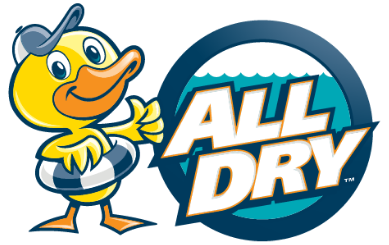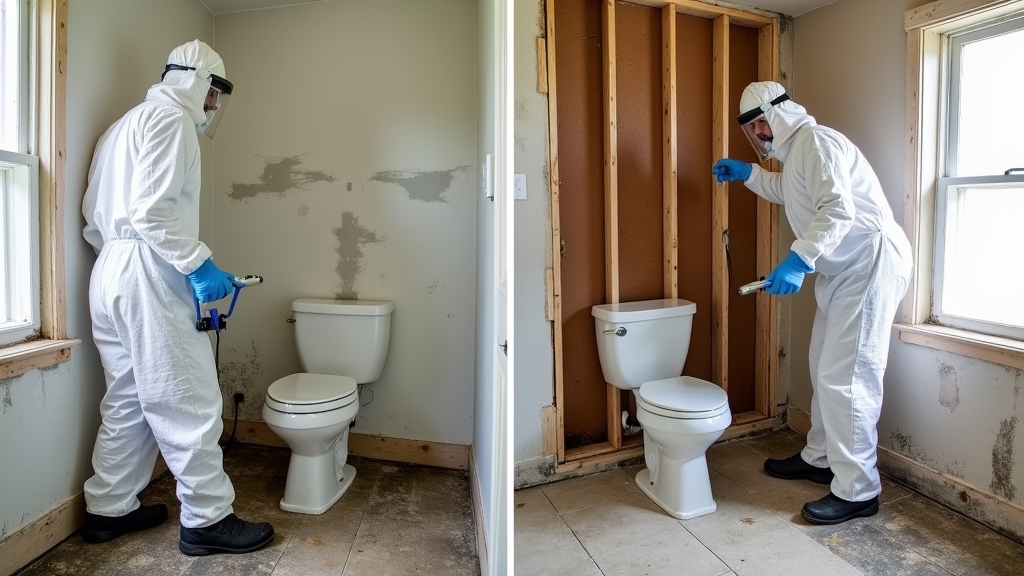Mold mitigation involves rapid temporary intervention to halt fungal growth through moisture controlwithin 24-48 hours of intrusion. Remediationencompasses complete contamination eliminationand verification testing. Mitigation uses basic equipment for preliminary cleaning, while remediation requires advanced HEPA filtration and containment systems. Insurance typically covers mitigation from covered perils, but remediation often faces coverage limitations. Cost considerations differ greatly, with mitigation offering lower upfront expenses but potential recurring interventions. Further exploration reveals vital distinctions affecting occupant health outcomes.
Key Takeaways
- Mitigation focuses on preventing further mold growth, while remediation eliminates existing contamination completely.
- Mitigation involves temporary containment and moisture control, whereas remediation includes thorough removal of affected materials.
- Mitigation uses basic moisture detection tools, while remediation requires advanced containment barriers and commercial-grade filtration systems.
- Remediation offers better health outcomes by eliminating microscopic spores that mitigation might leave behind.
- Mitigation has lower upfront costs but may require repeated treatments, while remediation demands higher initial investment but provides lasting results.
Defining Mold Mitigation: First Response to Fungal Growth

When confronted with unwanted fungal growth in a structure, mold mitigationrepresents the initial strategic response designed to halt further proliferation. This process encompasses the identification of moisture sources, implementation of humidity control measures, and isolation of affected areas to prevent cross-contaminationthroughout the building envelope.
Effective mitigation requires swift action following discovery, typically within 24-48 hours of moisture intrusion, as mold colonies can establish rapidly on susceptible substrates.
Professionals executing mitigation protocols employ specialized containment barriers, negative air pressure systems, and HEPA filtrationto minimize spore dispersion. The process also includes preliminary removal of visibly contaminated materials and application of EPA-registered antimicrobial agentsto temporarily suppress active mold growth until thorough remediation can commence.
The Scope of Mold Remediation: Beyond Immediate Control

While mitigation addresses immediate fungal control, mold remediationconstitutes a thorough restoration processthat systematically eliminates existing contaminationand prevents future recurrence.
Remediation professionals analyze the entire mold lifecycle to develop exhaustive protocols tailored to specific contamination scenarios. This scientific approach guarantees destruction of both visible growth and microscopic spores embedded within building materials.
Scientifically engineered remediation protocols target both visible mold and embedded spores through lifecycle-based intervention strategies.
- Complete removal of affected materials through controlled demolition techniques
- HEPA filtration of contaminated air spaces to capture airborne spores
- Implementation of long-term prevention strategies including moisture control systems and building envelope modifications
Remediation encompasses post-treatment verification testingto confirm successful eradication, often utilizing air sampling and surface testing methodologies.
This data-driven confirmation distinguishes remediation from simpler mitigation efforts and provides occupants with documented evidence of restored environmental conditions.
Comparing Process Steps: What Each Approach Entails

Mold mitigation procedures typically involve immediate containment, moisture elimination, and preliminary cleaning to prevent further spread of mold spores.
In contrast, full remediation protocolsencompass thorough assessment, complete removalof affected materials, HEPA vacuuming, antimicrobial treatments, and post-remediation verification testing.
These distinct methodologies reflect the fundamental difference between temporarily controlling a mold situation versus systematically eliminating it through scientifically validated processes.
Mitigation Step Breakdown
Understanding the detailed process steps of mold mitigationreveals its distinct focus on immediate containmentrather than thorough removal. The procedure follows a systematic approach designed to halt active mold growth and implement prevention strategies before extensive remediation becomes necessary.
- Moisture source identification and elimination – technicians locate and address water intrusion points through plumbing repairs, dehumidification, or ventilation improvements.
- Containment establishment – physical barriers using polyethylene sheeting and negative air pressure systems isolate affected areas to prevent cross-contamination.
- Surface treatment application – antimicrobial agents are applied to affected surfaces to neutralize active spores while specialized HEPA filtration systems remove airborne particulates.
This mitigation protocol provides essential initial stabilization of mold situations, creating conditions where further proliferation ceases while preparing for potential subsequent remediation requirements.
Full Remediation Protocols
In contrast to mitigation’s containment focus, full remediation protocolsinvolve an extensive set of procedures designed to completely eliminate mold coloniesand restore affected areas to pre-infestation conditions.
These protocols typically begin with thorough assessmentusing specialized equipment to determine contamination extent and identify mold species.
Remediation teams then implement containment zoneswith negative air pressure, HEPA filtration, and full PPE requirements. The process includes complete removal of affected materials, intensive cleaning with biocides, and addressing underlying moisture sources.
Understanding the mold lifecycle informs technicians about proper elimination techniques for both visible growth and microscopic spores.
Final steps include clearance testing, reconstruction of removed structures, and implementation of prevention strategiessuch as humidity control systems and periodic inspections to guarantee complete eradication and prevent recurrence.
Equipment and Techniques Used in Mitigation vs. Remediation
Mold mitigation and remediation processesutilize distinct equipment that reflects their different scopes and objectives.
Mitigation typically employs basic moisture detection toolsand portable HEPA vacuum systems, while remediation requires advanced containment barriers, negative air pressure systems, and commercial-grade HEPA filtration units with higher capacity.
The technological sophistication increases considerably in remediation scenarios, where specialized moisture mapping instrumentscan detect water intrusion within structural components and thermal imaging cameras identify temperature variations that indicate potential hidden mold colonies.
Specialized Containment Systems
Proper containment represents the cornerstone of effective mold controloperations, with significant differences between mitigationand remediationapproaches.
Mitigation typically employs limited containment barriers, often utilizing polyethylene sheeting to isolate affected areas while preventing cross-contamination.
Remediation demands extensive containment systemswith negative air pressuredifferentials, HEPA filtration, and decontamination chambersto maintain superior air qualitythroughout the process.
- Primary Containment Systems – Remediation requires critical barriers with sealed seams, while mitigation may use simple barriers with less rigorous sealing protocols.
- Pressure Differential Management – Remediation utilizes negative air machines calibrated to 0.02-0.04″ water column, compared to basic ventilation in mitigation.
- Decontamination Protocols – Remediation incorporates multi-chamber airlocks with HEPA vacuuming stations versus simplified entry/exit procedures in mitigation.
HEPA Filtration Differences
Both approaches’ effectiveness depends greatly on their HEPA filtration protocols, which differ markedly in scope, technical specifications, and implementation.
Mitigation typically employs portable HEPA air scrubberswith standard filtration capacity (99.97% efficiency at 0.3 microns), primarily focused on preventing cross-contaminationduring initial containment phases.
Remediation demands industrial-grade HEPA filtration systemswith enhanced specifications, including multi-stage filtration arraysand higher air exchange rates.
These systems incorporate specialized pre-filters and activated carbon components to capture mycotoxins alongside spores.
HEPA filter types also diverge notably—mitigation utilizes standardized filters requiring replacement after 30-40 hours of operation, while remediation employs high-capacity filtersdesigned for continuous operation throughout the project duration, enhancing overall HEPA filtration effectiveness and ensuring complete removal of microscopic fungal particulates.
Moisture Detection Tools
The identification of water intrusion sourcesrepresents the foundational difference between mitigation and remediationmoisture detection protocols.
While mitigation typically employs basic moisture metersto locate evident moisture sources, remediation requires thorough detection methods to identify concealed water intrusion points that facilitate mold colonization.
Advanced moisture detection technologies distinguish remediation from standard mitigation procedures:
- Thermal imaging cameras – Remediation specialists utilize infrared technology to detect temperature differentials indicating hidden moisture behind walls or under flooring.
- Moisture mapping software – Documents moisture migration patterns through structural components for targeted remediation strategy development.
- Hygrometers with data logging – Monitors environmental conditions over time to identify recurring moisture sources that standard mitigation might overlook.
These specialized tools enable remediation professionals to address root causesrather than merely treating visible symptoms.
Health Considerations: Which Approach Best Protects Occupants
When evaluating mold mitigation versus remediationapproaches, occupant healthshould remain the paramount consideration in decision-making processes.
Remediation typically offers superior occupant safety outcomesas it completely eliminates the source contaminationrather than merely controlling its spread.
Mitigation strategies, while less invasive and costly, may leave behind microscopic sporesthat continue to pose health risks, particularly for immunocompromised individuals, children, and those with respiratory conditions.
Remediation protocols incorporate more thorough containment procedures, negative air pressure environments, and HEPA filtration systems that greatly reduce airborne contaminants during the removal process.
The decision matrix should weigh short-term occupancy disruption against long-term health protection benefits.
Proper post-treatment clearance testingremains essential regardless of approach, ensuring that indoor air qualitymeets acceptable health standards before reoccupation.
Cost Factors: Budgeting for Mold Intervention
Understanding cost structuresrepresents a central consideration when selecting between mold mitigationand remediation approaches.
Thorough cost analysis reveals remediation typically demands higher initial investmentdue to its extensive removal protocols, specialized equipment requirements, and certified personnel. Mitigation offers more modest upfront expenditures but may necessitate repeated interventions if underlying issues persist.
Effective budgeting strategies include:
- Obtaining multiple detailed quotes specifying labor, materials, and potential contingencies
- Factoring long-term expenses including post-intervention testing and potential property value impacts
- Investigating insurance coverage parameters, as policies typically cover remediation for sudden events but exclude gradual moisture problems
Organizations and homeowners should evaluate both immediate fiscal constraints and extended financial implicationswhen determining appropriate intervention levels.
Recognizing that inadequate initial investment frequently results in amplified future expenditures.
Insurance Coverage: What Your Policy Might Include
Insurance policies frequently contain nuanced provisions regarding mold-related damages, creating significant variations in coverage parameters across different providers and policy types. Homeowners should carefully review their policies for specific mold coverage limitations and coverage exclusions that might affect claims for mitigation versus remediation services.
| Coverage Type | Mitigation | Remediation |
| Standard Homeowners | Often covered if resulting from covered peril | Frequently excluded or capped |
| Water Damage Rider | May include emergency mitigation | Limited scope for extensive remediation |
| Specialized Mold Endorsement | Expanded mitigation coverage | Higher coverage limits for full remediation |
Most insurers distinguish between sudden/accidental events and long-term moisture problems, typically covering the former while excluding the latter. Policy limitations often manifest as strict monetary caps, sometimes as low as $5,000 for mold-related claims.
When to Choose Mitigation vs. Full Remediation
Beyond insurance considerations, homeowners facing mold issuesmust make informed decisions about whether mitigation measuressuffice or full remediationbecomes necessary. The selection depends primarily on contamination extent, health impacts, and structural concerns. Properly evaluating these factors requires professional assessmentto determine appropriate intervention levels.
Key decision factors include:
- Contamination Parameters – Small isolated growths (<10 square feet) typically qualify for mitigation scenarios, while extensive infestations affecting multiple surfaces or hidden areas necessitate thorough remediation timelines.
- Health Sensitivity – Occupants with respiratory conditions, compromised immunity, or allergies warrant more aggressive remediation approaches regardless of visible growth extent.
- Structural Integrity – Mold affecting load-bearing components requires remediation, while superficial contamination on non-porous surfaces may respond adequately to mitigation techniques.
The correct approach balances immediate containment needsagainst long-term elimination requirements, considering both safety and financial implications.
Professional Qualifications: Who Should Perform Each Service
The credentials and expertise required for mold-related servicesdiffer markedly between mitigation and remediationprojects, reflecting the varying complexity and risk levels associated with each intervention type.
Mold service qualifications align with project complexity—basic certifications for mitigation, advanced credentials for comprehensive remediation.
Mold mitigation technicians typically need basic industry certifications, such as those from the Institute of Inspection Cleaning and Restoration Certification (IICRC), which focus on water damage restoration and mold awareness. These professionals should demonstrate competence in moisture detectionand preliminary containment procedures.
Remediation specialists, conversely, must meet more stringent service qualifications, including advanced certificationsfrom organizations like the American Council for Accredited Certification (ACAC). These credentials verify expertise in thorough mold assessment, advanced containment protocols, and safe removal techniques.
Many jurisdictions mandate specific certification requirementsfor remediation contractors, particularly for projects exceeding certain square footage or involving sensitive environments like healthcare facilities.
Mold Mitigation vs. Remediation: Key Takeaways ExplainedConclusion
Understanding the difference between mold mitigation and remediation is essential for protecting your property, health, and long-term investment. While mitigation provides quick, temporary control, remediation ensures complete elimination and lasting results. Choosing the right approach depends on contamination extent, health risks, and structural integrity—decisions that should always be guided by certified professionals.
If you’re facing mold issues, don’t leave it to guesswork. TrustAll Dry Services of North Las Vegasfor expert help. Our team specializes inmold removal services,water damage restoration, andfire damage restoration, delivering proven solutions that restore safety and peace of mind.
Take the first step toward a healthier home—request service todayor call 702-213-7391for a professional assessment.

